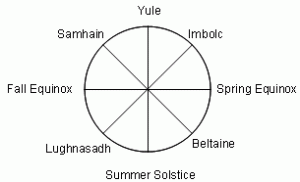The Wheel of the Year
The Wheel of the Year

Many Pagans observe and participate in the seasonal festivals of the wheel of the year. The Wiccan Sabbats are tied to the seasons of the year as well as the calendar. The Wiccan Sabbats are still practiced within the ancient European societies. Certain events take place on a particular date and all Wiccans believe that the dates in which the events took place are still of special importance to the culture.Depending on what the Pagan celebrates there are four to eight festivals a year. The eight festivals of the wheel of the year include: Yule December 20-23, Imbolc February 2, Ostara March 19-22, Beltane May 1, Midsummer June 19-23, Lughnasadh August 1, Mabon September 21-24, and Samhain November 1. In a lot of traditions many Pagans believe that time is never ending or changing when it comes to the “growth and retreat that is tied to the suns annual death and rebirth.”
Yule: or midwinter, is the reduction of the suns presence in the sky and also the “rebirth of the solar god”. This is also a time that the seasons of fertility return. During this midwinter festival sometimes sacrifices are made, but usually having a feast and the giving of gifts are tradition. Another tradition is that Pagans will celebrate by decorating with evergreens.
Imbolc is the celebration that is usually the first movement of the season of spring. The years new growth of life is prepared by “spring cleaning” and also the purification of the home. Imbolc which normally takes place on February 2nd is a festival that celebrates fertility. As part of this special celebration milk is poured on top of soil as a sacrifice or offering. In addition, there is always special color associated with a particular celebration within the Wiccan culture. The colors pink and red are of special significance during the Imbolc.
Vernal Equinox, also called Ostara, is a common tradition of this time to decorate eggs. Ostara is a fertility goddess that Germanic Pagans celebrate on this holiday.
Beltane is a festival that maypole dancing, dancing with a wooden pole, and also crowning of the queen of the may are well known for this festival.Beltane is another very special holiday in which a festival takes place. Beltane essentially marks the very first day of summer. In addition, Beltane celebrates the death of winter and the birth of the warm summer. This special holiday also stresses the importance of human fertility. For thousands of years the Beltane festival is associated with honeysuckle as well as rosemary. In addition, two very special colors that are associated with this event are green and red. Therefore, many locals will dress appropriately for this important occasion.
Litha, or midsummer, is believed that the sun has reached its longest time of sunshine. Midsummer is considered one of the solar holidays and also considered a turning point of the summer season. This turning point is where the height of summer is reached.
Lammas or Lughnasadh is one of the Wiccan harvest festivals. The mark of Wiccan’s on this holiday is symbolized by baking a god figure in bread and then feasting on the bread. The baking and feasting are to symbolize the importance of the Lammas harvest. The first fruits of the Lammas harvest were symbolized by the thanksgiving feast in return for grain and bread.
One of the minor holidays that the ancient Europeans still celebrate is that of the Mabon. The Mabon takes place on September 21st. A small festival or celebration takes place which marks the start of the fall season. In addition, within ancient times the Mabon marked the descent or departure of the Goddess into the underworld. Both Topaz and wheat have a special significance during the Mabon celebration. Autumnal Equinox is a thanksgiving ritual celebrated by Pagans. The reason for this celebration is to have the need of sharing all of the earthly fruits and secure blessings. The blessings are meant for the goddess and god to prepare and protect from the coming winter months.
Samhain is believed to celebrate those who have died. This celebration can include: ancestors, family, elders of the faith, friends, pets, and any other people that have been loved. During this time some people of this faith invite the dead to share the holiday with them. The communication of the dead with the living during this holiday is believed to be the “thinnest point” in the world where the living can communicate with the dead. Another holiday which is celebrated is that of the Samhain. Samhain simply means the end of the summer and start or beginning of winter. In addition, the Samhain is considered the end of the harvest season. A festival usually takes place and great emphasis is placed on the colors black and orange. Decorations are displayed which contain black and orange. Also, many locals will almost always dress in attire which displays the colors associated with this holiday. The Samhain is also referred to as the “last harvest” or the “blood feast”. This event almost always occurs on the last day of October. Therefore, the Samhain takes place on Halloween.
The Wiccan Esbats are special beliefs and traditions still practiced by the Pagan religion. The Pagan religion has always worshiped various gods and goddesses and will continue to do so as part of their culture. The gods and goddesses seem to play an important role not only in their culture but in their every day lives. Joseph Blandisi Jersey
